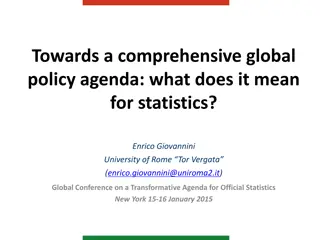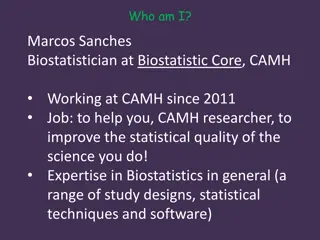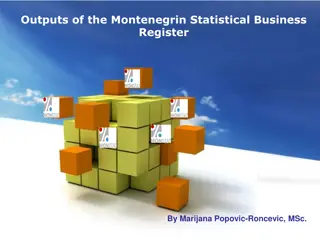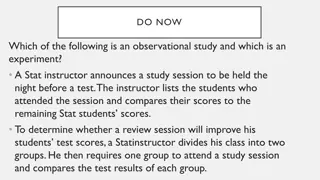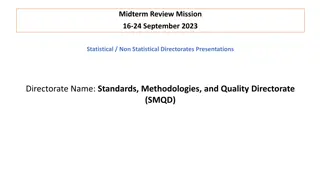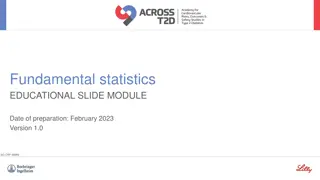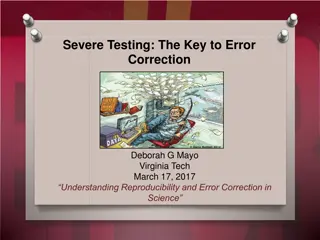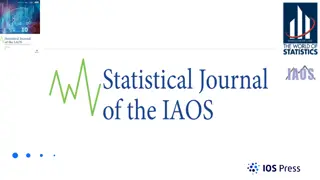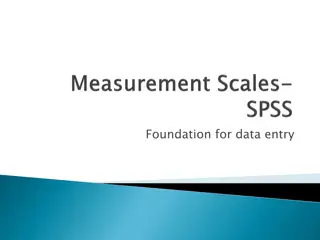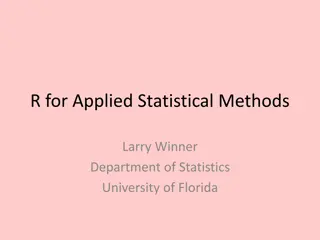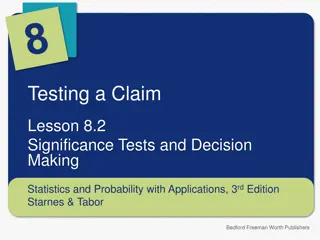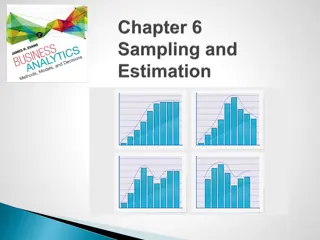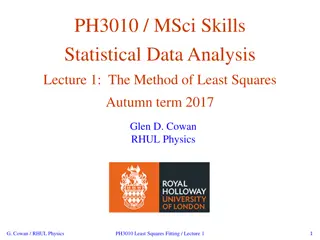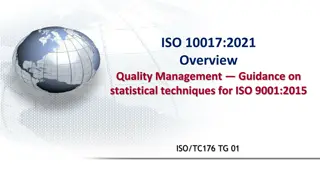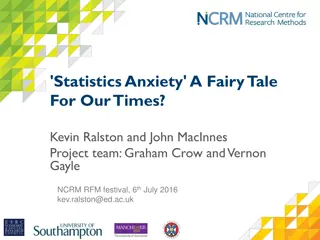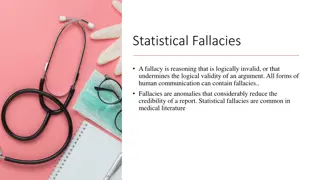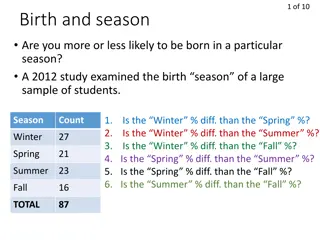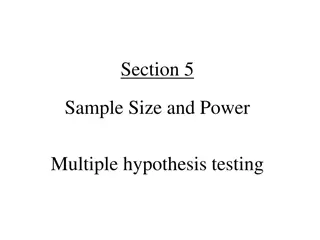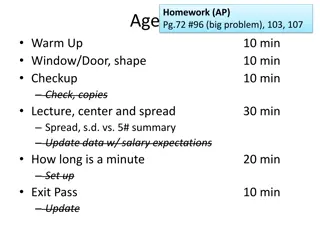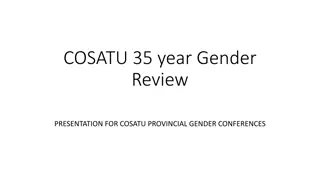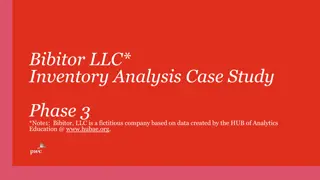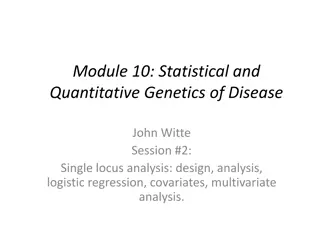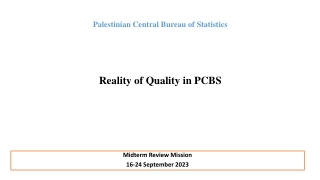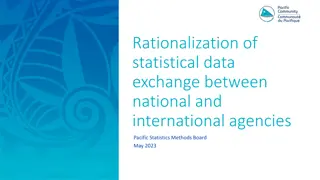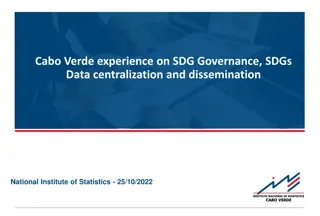Statistical Analysis Review - An Overview
Explore a diverse range of statistical topics including Chi-Square, Repeated Measures ANOVA, Factorial Design, and Correlation. Learn about scale measurement requirements for Chi-Square, assumptions violation, effect size measures, within-subjects design considerations, and more.
Download Presentation

Please find below an Image/Link to download the presentation.
The content on the website is provided AS IS for your information and personal use only. It may not be sold, licensed, or shared on other websites without obtaining consent from the author. Download presentation by click this link. If you encounter any issues during the download, it is possible that the publisher has removed the file from their server.
E N D
Presentation Transcript
230 Jeopardy Unit 4 Repeated- Measures ANOVA Chi-Square Factorial Design Factorial ANOVA Correlation $100 $100 $100 $100 $100 $200 $200 $200 $200 $200 $300 $300 $300 $300 $300 $400 $400 $400 $400 $400 $500 $500 $500 $500 $500
Chi-Square--$100 Data must be measured on this type of scale in order to use the Chi-Square statistic. . answer
Chi-Square--$200 The proportions specified by the null hypothesis are used to compute these. answer
Chi-Square--$300 If an individual in the sample is counted in more than one category, then this assumption is violated. answer
Chi-Square--$400 Use this test to determine whether consumers have a preference among four leading brands of toothpaste. answer
Chi-Square--$500 The measure of effect size used for a 2 x 2 matrix and a matrix larger than 2 x 2, respectively. answer
Repeated ANOVA--$100 The consistent performance (individual differences) of a subject is represented by this SS. answer
Repeated ANOVA--$200 Because the same participant serves in all treatments, individual differences are automatically removed as a source of variability in this SS. answer
Repeated ANOVA--$300 In a repeated measures design, if F(3, 24) = 4.67, then each participant serves in ___ treatment conditions. answer
Repeated ANOVA--$400 When figuring SSs in a within-subjects design, ___ is often referred to as the residual term because it is the variability left after ___ is subtracted from it. answer
Repeated ANOVA--$500 In a repeated-measures design, if k = 5 and dfTotal = 40, then dfWithin Treatments = ___. answer
Factorial Design--$100 A1= A2 assumes there will be no _________. answer
Factorial Design--$200 The major advantage of conducting a factorial experiment is the ability to assess this. answer
Factorial Design--$300 The two values you need to look up the critical value of FAxB. answer
Factorial Design--$400 In a factorial design, these effects may not accurately represent the mean differences between individual treatment conditions. answer
Factorial Design--$500 The analysis that looks for mean differences within an individual column (or row) of the treatment matrix. answer
Factorial ANOVA--$100 The number of hypothesis tests included in a two-factor ANOVA. answer
Factorial ANOVA--$200 In a factorial experiment, this type of variability is partitioned into 3 components. answer
Factorial ANOVA--$300 When looking at an AB treatment matrix, the numbers that enter into tests of main effects. answer
Factorial ANOVA--$400 In a 4x2 factorial design, the number of treatment totals entering into the analysis for the interaction. answer
Factorial ANOVA--$500 In order to graph the interaction, calculate _____ and plot them. Lines that _______ indicate the possibility of an interaction. answer
Correlation--$100 When two variables tend to move in the same direction answer
Correlation--$200 A perfect correlation is indicated by a correlation coefficient of answer
Correlation--$300 On a scatterplot, a negative correlation looks like this answer
Correlation--$400 Compute this to determine whether a consistent relationship exists between two rank-order measures. answer
Correlation--$500 Conceptually, the Pearson correlation coefficient is computed by dividing _________ by _________. answer
Chi-Square--$100 A: What is nominal (or ordinal)? Back to board
Chi-Square--$200 A: What are expected frequencies? Back to board
Chi-Square--$300 A: What is the assumption of independence? Back to board
Chi-Square--$400 A: What is goodness of fit? Back to board
Chi-Square--$500 A: What is phi and Cramer s V? Back to board
Repeated-M ANOVA--$100 A: What is SS Between Subjects? Back to board
Repeated-M ANOVA--$200 A: What is SS Between Treatments? Back to board
Repeated-M ANOVA--$300 A: What is 4? Back to board
Repeated-M ANOVA--$400 A: What is SSerror and SSBetween Subjects? Back to board
Repeated-M ANOVA--$500 A: What is 36? Back to board
Factorial Design--$100 A: What is no main effect of A? Back to board
Factorial Design--$200 A: What is an interaction? Back to board
Factorial Design--$300 A: What are dfAxB(numerator) & df Within Treatment (denominator)? Back to board
Factorial Design--$400 A: What are main effects? Back to board
Factorial Design--$500 A: What is simple main effects? Back to board
Factorial ANOVA--$100 A: What are 3? Back to board
Factorial ANOVA--$200 A: What is between treatments? Back to board
Factorial ANOVA--$300 A: What are column (or row) totals (or means)? Back to board
Factorial ANOVA--$400 A: What are 8? Back to board
Factorial ANOVA--$500 A: What are treatment means and converge or cross? Back to board
Correlation--$100 A: What is a positive correlation? Back to board
Correlation--$200 A: What is 1 (positive & negative)? Back to board
Correlation--$300 A: What is an envelope moving down from left to right? Back to board
Correlation--$400 A: What is the Spearman correlation? Back to board










